SHR011-6: Leadership Styles, Performance, and Capabilities Report
VerifiedAdded on 2022/12/30
|16
|3315
|44
Report
AI Summary
This report delves into various leadership styles, comparing and contrasting their characteristics and impacts on employee performance and organizational productivity. It explores the differences between transformational and transactional leadership, analyzing how each style influences employee satisfaction, motivation, and overall output. The report further investigates how different leadership approaches affect individual performance, considering factors such as employee commitment, communication, and work ethics. The report examines the determination of how individuals follow certain leadership styles, including autocratic, laissez-faire, and democratic approaches. It concludes with an evaluation of the author's personal leadership capabilities using the Seven Leadership Mind-sets theory and a personal statement for an ideal job, demonstrating a comprehensive understanding of leadership principles and their practical application in a business context.
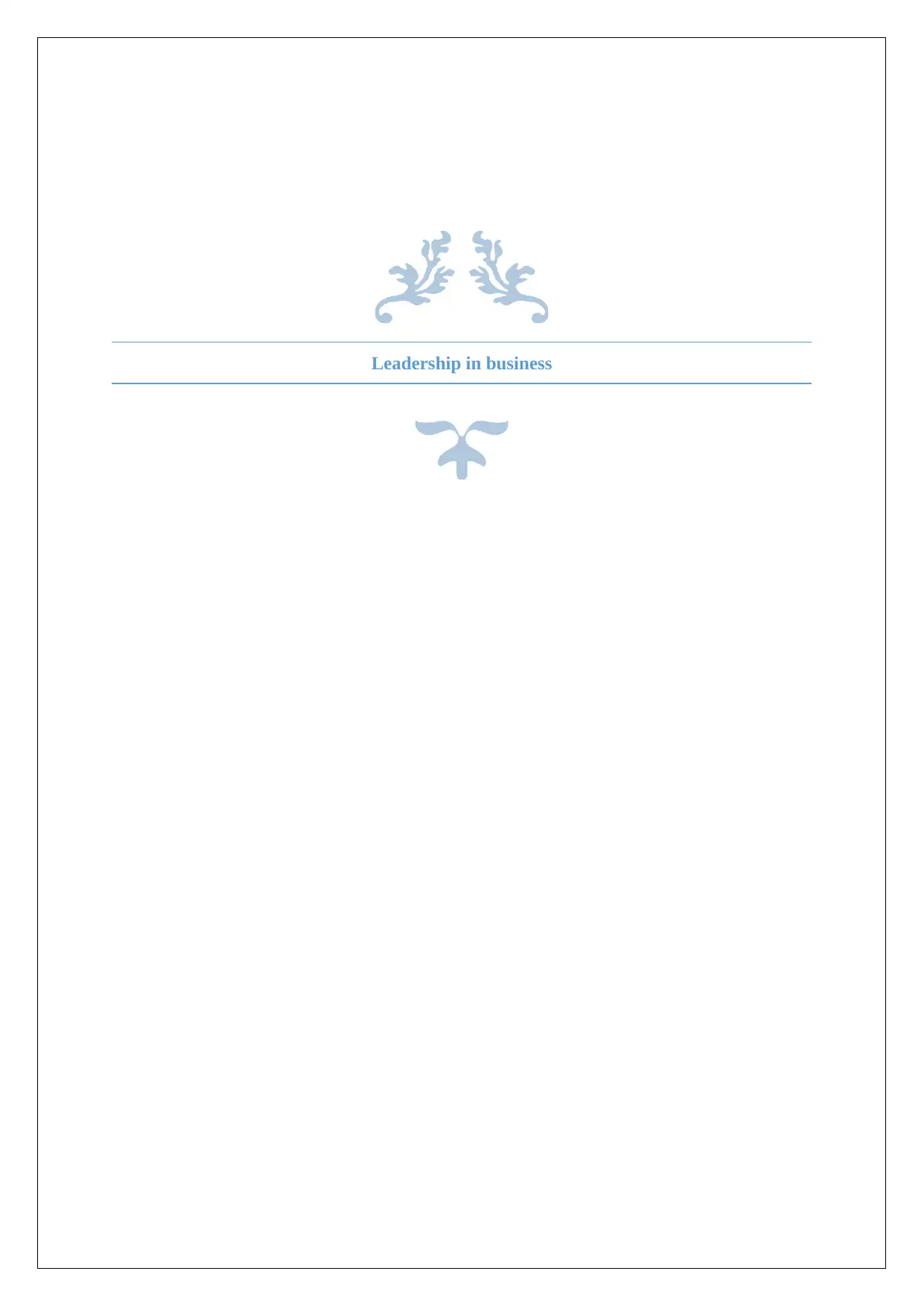
Leadership in business
Paraphrase This Document
Need a fresh take? Get an instant paraphrase of this document with our AI Paraphraser
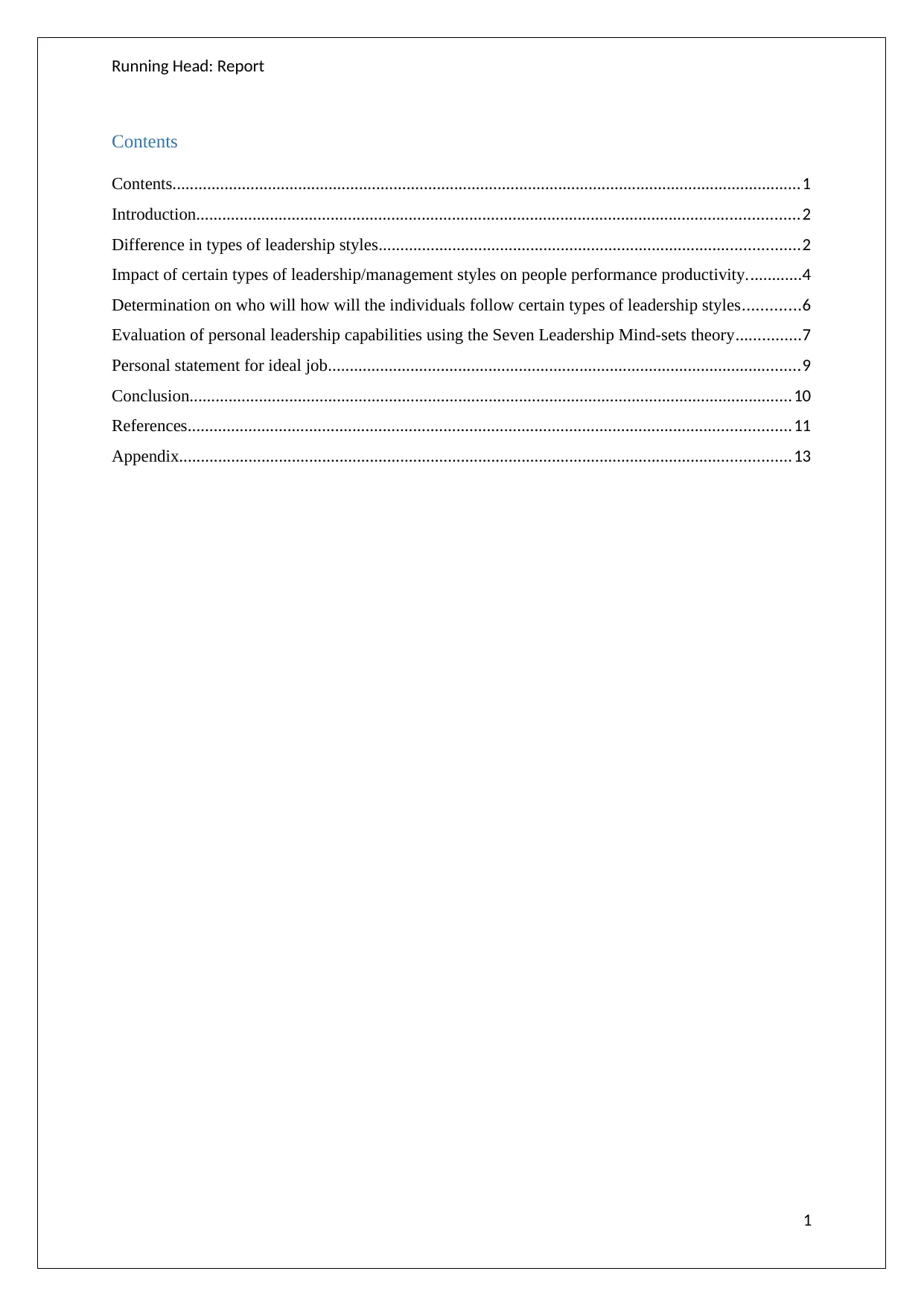
Running Head: Report
Contents
Contents.................................................................................................................................................1
Introduction...........................................................................................................................................2
Difference in types of leadership styles.................................................................................................2
Impact of certain types of leadership/management styles on people performance productivity.............4
Determination on who will how will the individuals follow certain types of leadership styles.............6
Evaluation of personal leadership capabilities using the Seven Leadership Mind-sets theory...............7
Personal statement for ideal job.............................................................................................................9
Conclusion...........................................................................................................................................10
References...........................................................................................................................................11
Appendix.............................................................................................................................................13
1
Contents
Contents.................................................................................................................................................1
Introduction...........................................................................................................................................2
Difference in types of leadership styles.................................................................................................2
Impact of certain types of leadership/management styles on people performance productivity.............4
Determination on who will how will the individuals follow certain types of leadership styles.............6
Evaluation of personal leadership capabilities using the Seven Leadership Mind-sets theory...............7
Personal statement for ideal job.............................................................................................................9
Conclusion...........................................................................................................................................10
References...........................................................................................................................................11
Appendix.............................................................................................................................................13
1
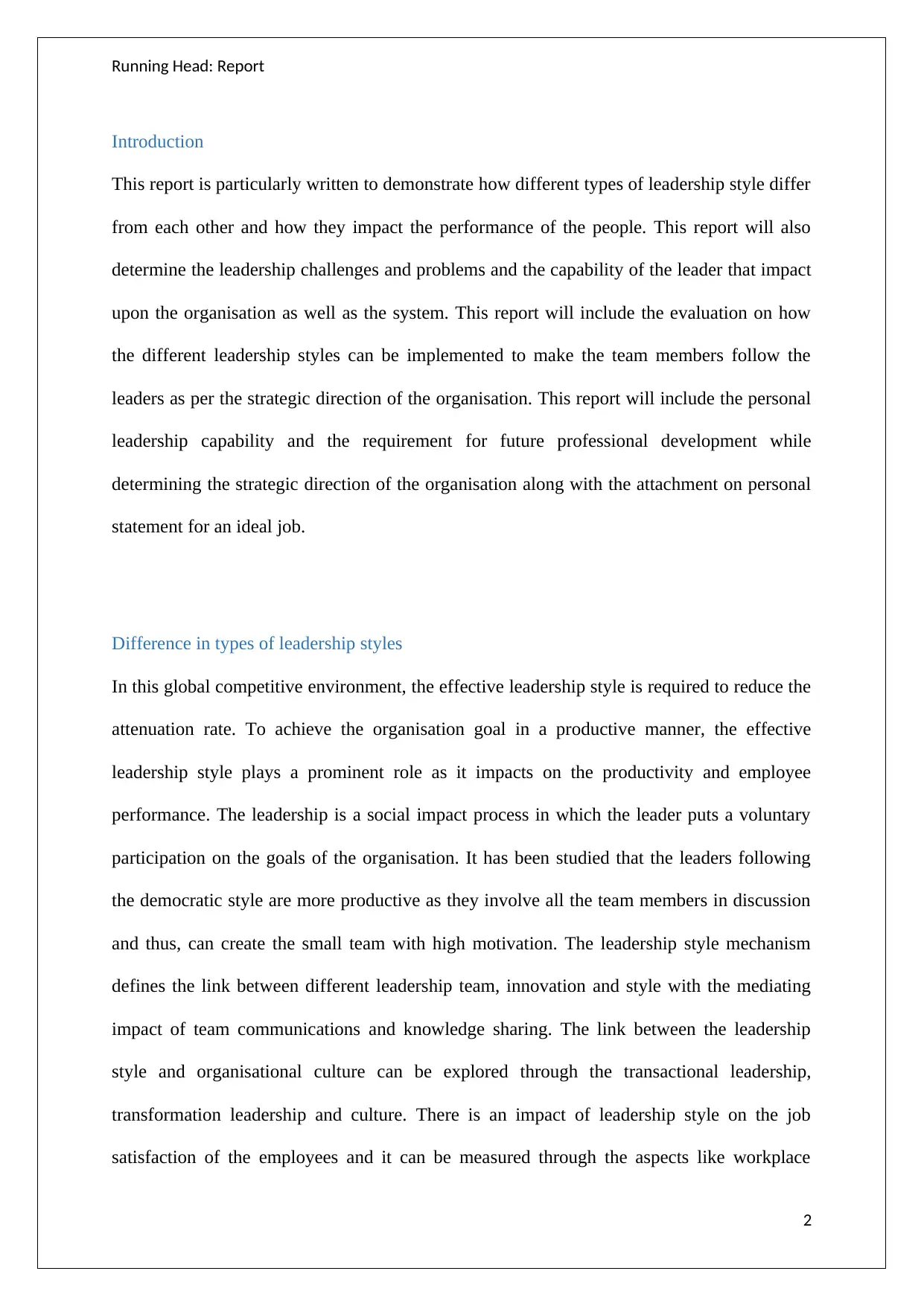
Running Head: Report
Introduction
This report is particularly written to demonstrate how different types of leadership style differ
from each other and how they impact the performance of the people. This report will also
determine the leadership challenges and problems and the capability of the leader that impact
upon the organisation as well as the system. This report will include the evaluation on how
the different leadership styles can be implemented to make the team members follow the
leaders as per the strategic direction of the organisation. This report will include the personal
leadership capability and the requirement for future professional development while
determining the strategic direction of the organisation along with the attachment on personal
statement for an ideal job.
Difference in types of leadership styles
In this global competitive environment, the effective leadership style is required to reduce the
attenuation rate. To achieve the organisation goal in a productive manner, the effective
leadership style plays a prominent role as it impacts on the productivity and employee
performance. The leadership is a social impact process in which the leader puts a voluntary
participation on the goals of the organisation. It has been studied that the leaders following
the democratic style are more productive as they involve all the team members in discussion
and thus, can create the small team with high motivation. The leadership style mechanism
defines the link between different leadership team, innovation and style with the mediating
impact of team communications and knowledge sharing. The link between the leadership
style and organisational culture can be explored through the transactional leadership,
transformation leadership and culture. There is an impact of leadership style on the job
satisfaction of the employees and it can be measured through the aspects like workplace
2
Introduction
This report is particularly written to demonstrate how different types of leadership style differ
from each other and how they impact the performance of the people. This report will also
determine the leadership challenges and problems and the capability of the leader that impact
upon the organisation as well as the system. This report will include the evaluation on how
the different leadership styles can be implemented to make the team members follow the
leaders as per the strategic direction of the organisation. This report will include the personal
leadership capability and the requirement for future professional development while
determining the strategic direction of the organisation along with the attachment on personal
statement for an ideal job.
Difference in types of leadership styles
In this global competitive environment, the effective leadership style is required to reduce the
attenuation rate. To achieve the organisation goal in a productive manner, the effective
leadership style plays a prominent role as it impacts on the productivity and employee
performance. The leadership is a social impact process in which the leader puts a voluntary
participation on the goals of the organisation. It has been studied that the leaders following
the democratic style are more productive as they involve all the team members in discussion
and thus, can create the small team with high motivation. The leadership style mechanism
defines the link between different leadership team, innovation and style with the mediating
impact of team communications and knowledge sharing. The link between the leadership
style and organisational culture can be explored through the transactional leadership,
transformation leadership and culture. There is an impact of leadership style on the job
satisfaction of the employees and it can be measured through the aspects like workplace
2
⊘ This is a preview!⊘
Do you want full access?
Subscribe today to unlock all pages.

Trusted by 1+ million students worldwide
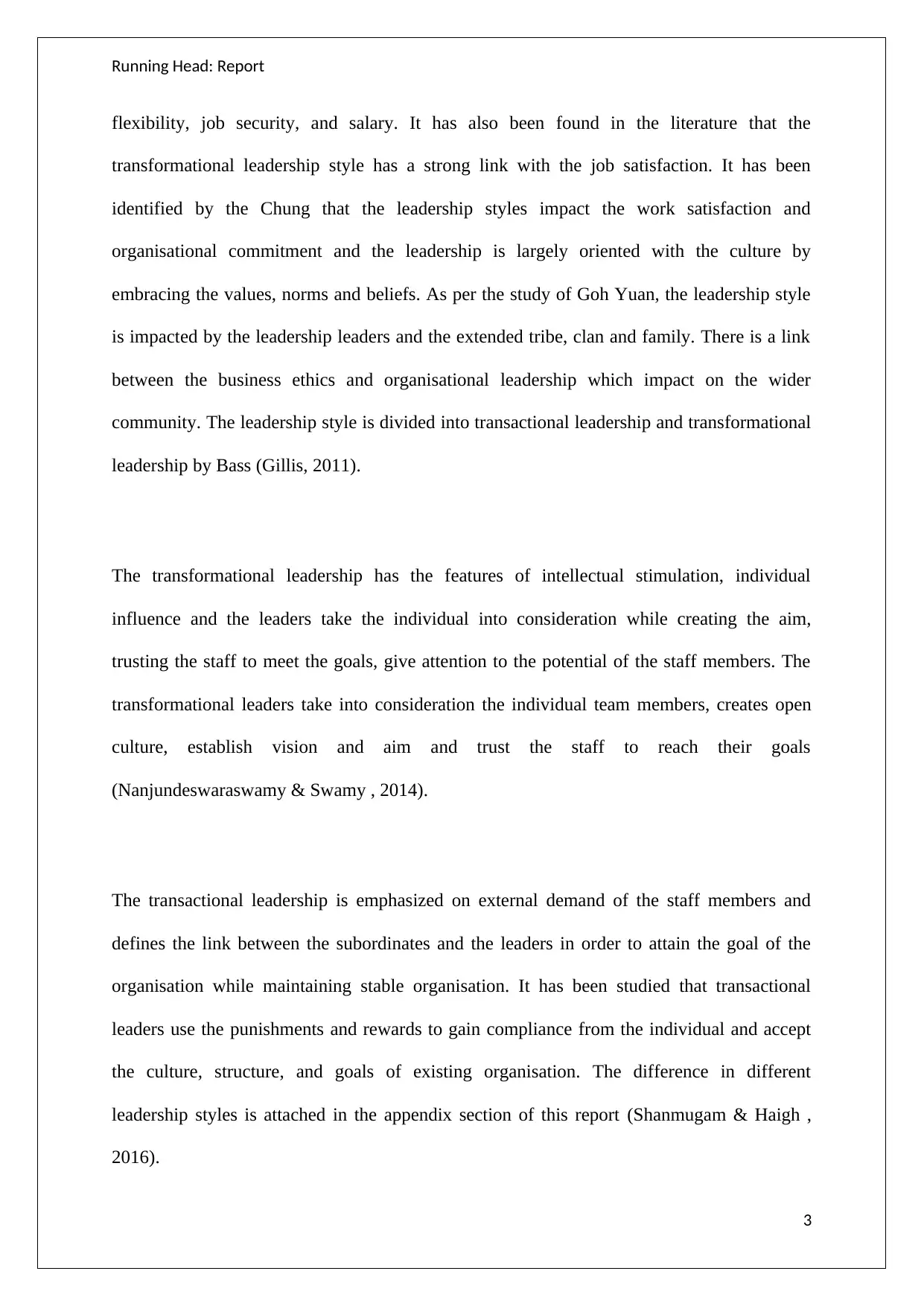
Running Head: Report
flexibility, job security, and salary. It has also been found in the literature that the
transformational leadership style has a strong link with the job satisfaction. It has been
identified by the Chung that the leadership styles impact the work satisfaction and
organisational commitment and the leadership is largely oriented with the culture by
embracing the values, norms and beliefs. As per the study of Goh Yuan, the leadership style
is impacted by the leadership leaders and the extended tribe, clan and family. There is a link
between the business ethics and organisational leadership which impact on the wider
community. The leadership style is divided into transactional leadership and transformational
leadership by Bass (Gillis, 2011).
The transformational leadership has the features of intellectual stimulation, individual
influence and the leaders take the individual into consideration while creating the aim,
trusting the staff to meet the goals, give attention to the potential of the staff members. The
transformational leaders take into consideration the individual team members, creates open
culture, establish vision and aim and trust the staff to reach their goals
(Nanjundeswaraswamy & Swamy , 2014).
The transactional leadership is emphasized on external demand of the staff members and
defines the link between the subordinates and the leaders in order to attain the goal of the
organisation while maintaining stable organisation. It has been studied that transactional
leaders use the punishments and rewards to gain compliance from the individual and accept
the culture, structure, and goals of existing organisation. The difference in different
leadership styles is attached in the appendix section of this report (Shanmugam & Haigh ,
2016).
3
flexibility, job security, and salary. It has also been found in the literature that the
transformational leadership style has a strong link with the job satisfaction. It has been
identified by the Chung that the leadership styles impact the work satisfaction and
organisational commitment and the leadership is largely oriented with the culture by
embracing the values, norms and beliefs. As per the study of Goh Yuan, the leadership style
is impacted by the leadership leaders and the extended tribe, clan and family. There is a link
between the business ethics and organisational leadership which impact on the wider
community. The leadership style is divided into transactional leadership and transformational
leadership by Bass (Gillis, 2011).
The transformational leadership has the features of intellectual stimulation, individual
influence and the leaders take the individual into consideration while creating the aim,
trusting the staff to meet the goals, give attention to the potential of the staff members. The
transformational leaders take into consideration the individual team members, creates open
culture, establish vision and aim and trust the staff to reach their goals
(Nanjundeswaraswamy & Swamy , 2014).
The transactional leadership is emphasized on external demand of the staff members and
defines the link between the subordinates and the leaders in order to attain the goal of the
organisation while maintaining stable organisation. It has been studied that transactional
leaders use the punishments and rewards to gain compliance from the individual and accept
the culture, structure, and goals of existing organisation. The difference in different
leadership styles is attached in the appendix section of this report (Shanmugam & Haigh ,
2016).
3
Paraphrase This Document
Need a fresh take? Get an instant paraphrase of this document with our AI Paraphraser
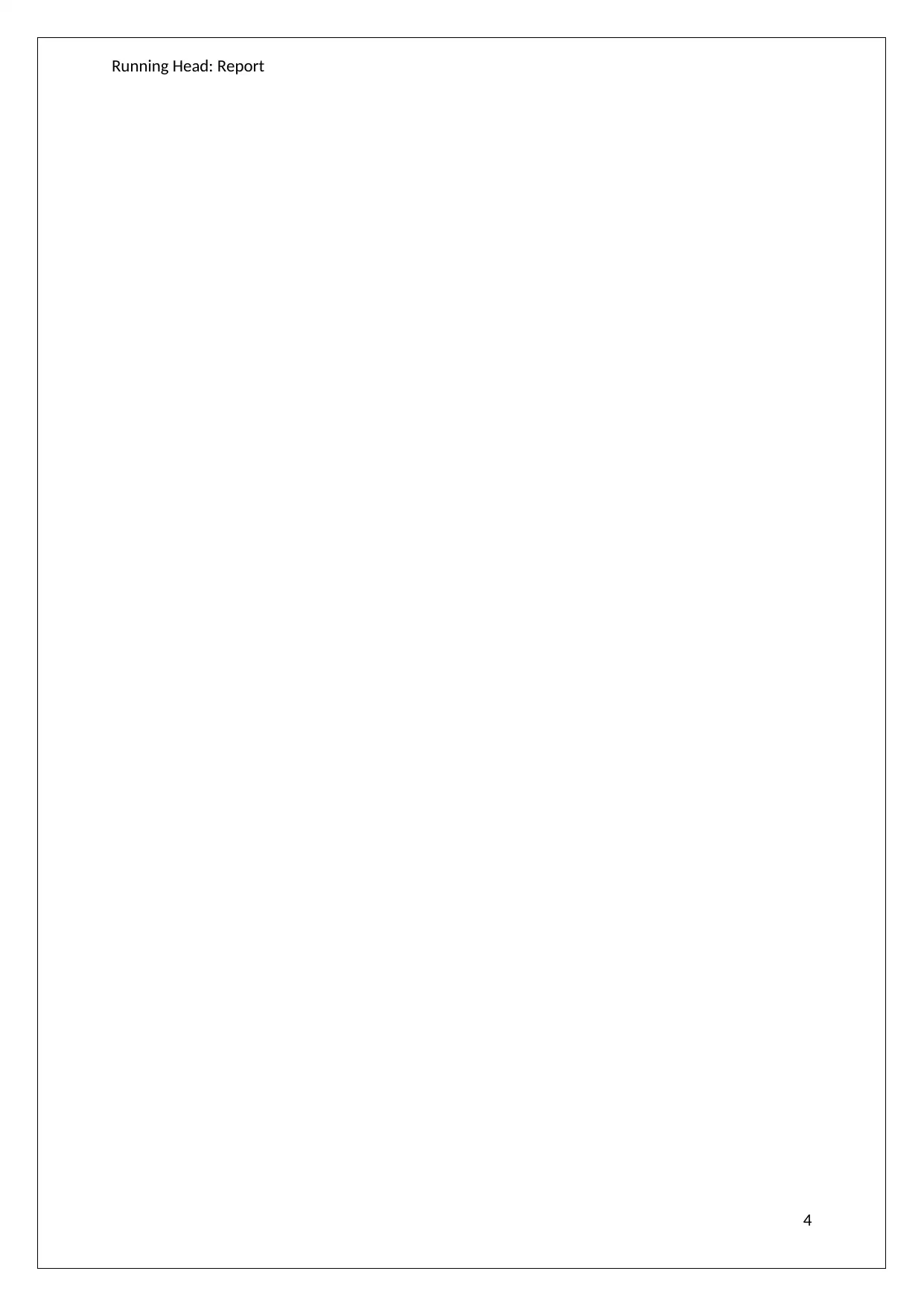
Running Head: Report
4
4
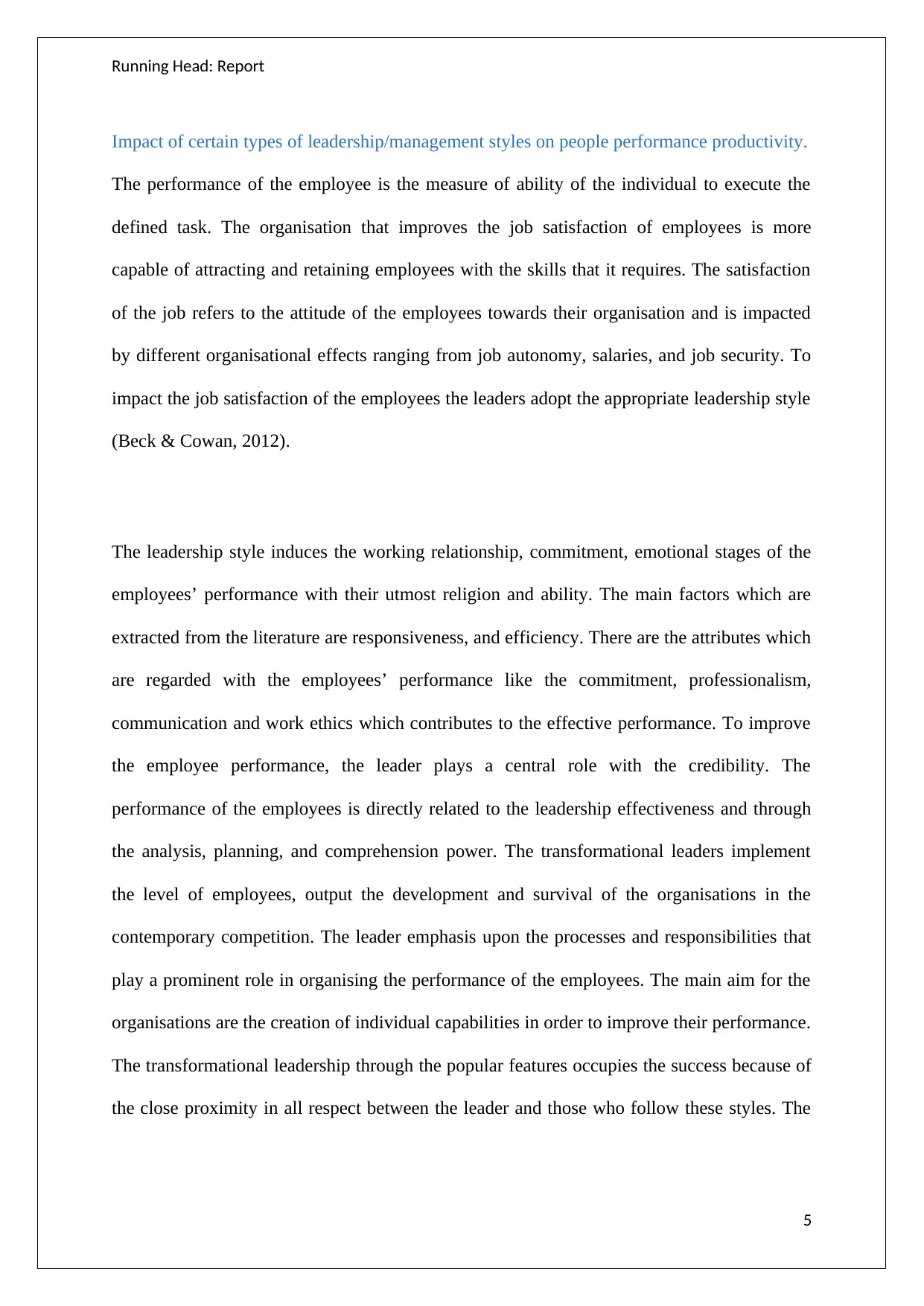
Running Head: Report
Impact of certain types of leadership/management styles on people performance productivity.
The performance of the employee is the measure of ability of the individual to execute the
defined task. The organisation that improves the job satisfaction of employees is more
capable of attracting and retaining employees with the skills that it requires. The satisfaction
of the job refers to the attitude of the employees towards their organisation and is impacted
by different organisational effects ranging from job autonomy, salaries, and job security. To
impact the job satisfaction of the employees the leaders adopt the appropriate leadership style
(Beck & Cowan, 2012).
The leadership style induces the working relationship, commitment, emotional stages of the
employees’ performance with their utmost religion and ability. The main factors which are
extracted from the literature are responsiveness, and efficiency. There are the attributes which
are regarded with the employees’ performance like the commitment, professionalism,
communication and work ethics which contributes to the effective performance. To improve
the employee performance, the leader plays a central role with the credibility. The
performance of the employees is directly related to the leadership effectiveness and through
the analysis, planning, and comprehension power. The transformational leaders implement
the level of employees, output the development and survival of the organisations in the
contemporary competition. The leader emphasis upon the processes and responsibilities that
play a prominent role in organising the performance of the employees. The main aim for the
organisations are the creation of individual capabilities in order to improve their performance.
The transformational leadership through the popular features occupies the success because of
the close proximity in all respect between the leader and those who follow these styles. The
5
Impact of certain types of leadership/management styles on people performance productivity.
The performance of the employee is the measure of ability of the individual to execute the
defined task. The organisation that improves the job satisfaction of employees is more
capable of attracting and retaining employees with the skills that it requires. The satisfaction
of the job refers to the attitude of the employees towards their organisation and is impacted
by different organisational effects ranging from job autonomy, salaries, and job security. To
impact the job satisfaction of the employees the leaders adopt the appropriate leadership style
(Beck & Cowan, 2012).
The leadership style induces the working relationship, commitment, emotional stages of the
employees’ performance with their utmost religion and ability. The main factors which are
extracted from the literature are responsiveness, and efficiency. There are the attributes which
are regarded with the employees’ performance like the commitment, professionalism,
communication and work ethics which contributes to the effective performance. To improve
the employee performance, the leader plays a central role with the credibility. The
performance of the employees is directly related to the leadership effectiveness and through
the analysis, planning, and comprehension power. The transformational leaders implement
the level of employees, output the development and survival of the organisations in the
contemporary competition. The leader emphasis upon the processes and responsibilities that
play a prominent role in organising the performance of the employees. The main aim for the
organisations are the creation of individual capabilities in order to improve their performance.
The transformational leadership through the popular features occupies the success because of
the close proximity in all respect between the leader and those who follow these styles. The
5
⊘ This is a preview!⊘
Do you want full access?
Subscribe today to unlock all pages.

Trusted by 1+ million students worldwide
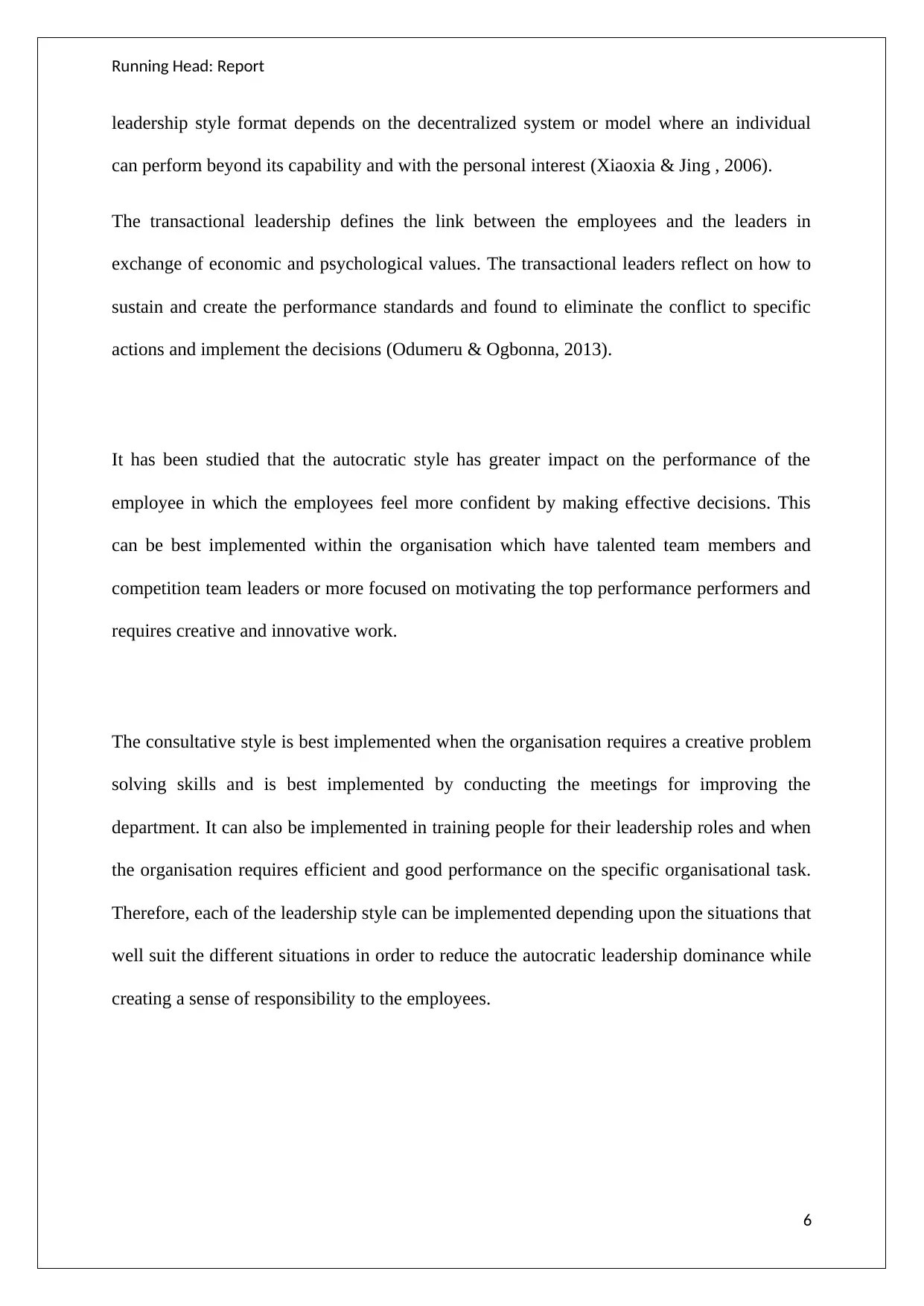
Running Head: Report
leadership style format depends on the decentralized system or model where an individual
can perform beyond its capability and with the personal interest (Xiaoxia & Jing , 2006).
The transactional leadership defines the link between the employees and the leaders in
exchange of economic and psychological values. The transactional leaders reflect on how to
sustain and create the performance standards and found to eliminate the conflict to specific
actions and implement the decisions (Odumeru & Ogbonna, 2013).
It has been studied that the autocratic style has greater impact on the performance of the
employee in which the employees feel more confident by making effective decisions. This
can be best implemented within the organisation which have talented team members and
competition team leaders or more focused on motivating the top performance performers and
requires creative and innovative work.
The consultative style is best implemented when the organisation requires a creative problem
solving skills and is best implemented by conducting the meetings for improving the
department. It can also be implemented in training people for their leadership roles and when
the organisation requires efficient and good performance on the specific organisational task.
Therefore, each of the leadership style can be implemented depending upon the situations that
well suit the different situations in order to reduce the autocratic leadership dominance while
creating a sense of responsibility to the employees.
6
leadership style format depends on the decentralized system or model where an individual
can perform beyond its capability and with the personal interest (Xiaoxia & Jing , 2006).
The transactional leadership defines the link between the employees and the leaders in
exchange of economic and psychological values. The transactional leaders reflect on how to
sustain and create the performance standards and found to eliminate the conflict to specific
actions and implement the decisions (Odumeru & Ogbonna, 2013).
It has been studied that the autocratic style has greater impact on the performance of the
employee in which the employees feel more confident by making effective decisions. This
can be best implemented within the organisation which have talented team members and
competition team leaders or more focused on motivating the top performance performers and
requires creative and innovative work.
The consultative style is best implemented when the organisation requires a creative problem
solving skills and is best implemented by conducting the meetings for improving the
department. It can also be implemented in training people for their leadership roles and when
the organisation requires efficient and good performance on the specific organisational task.
Therefore, each of the leadership style can be implemented depending upon the situations that
well suit the different situations in order to reduce the autocratic leadership dominance while
creating a sense of responsibility to the employees.
6
Paraphrase This Document
Need a fresh take? Get an instant paraphrase of this document with our AI Paraphraser
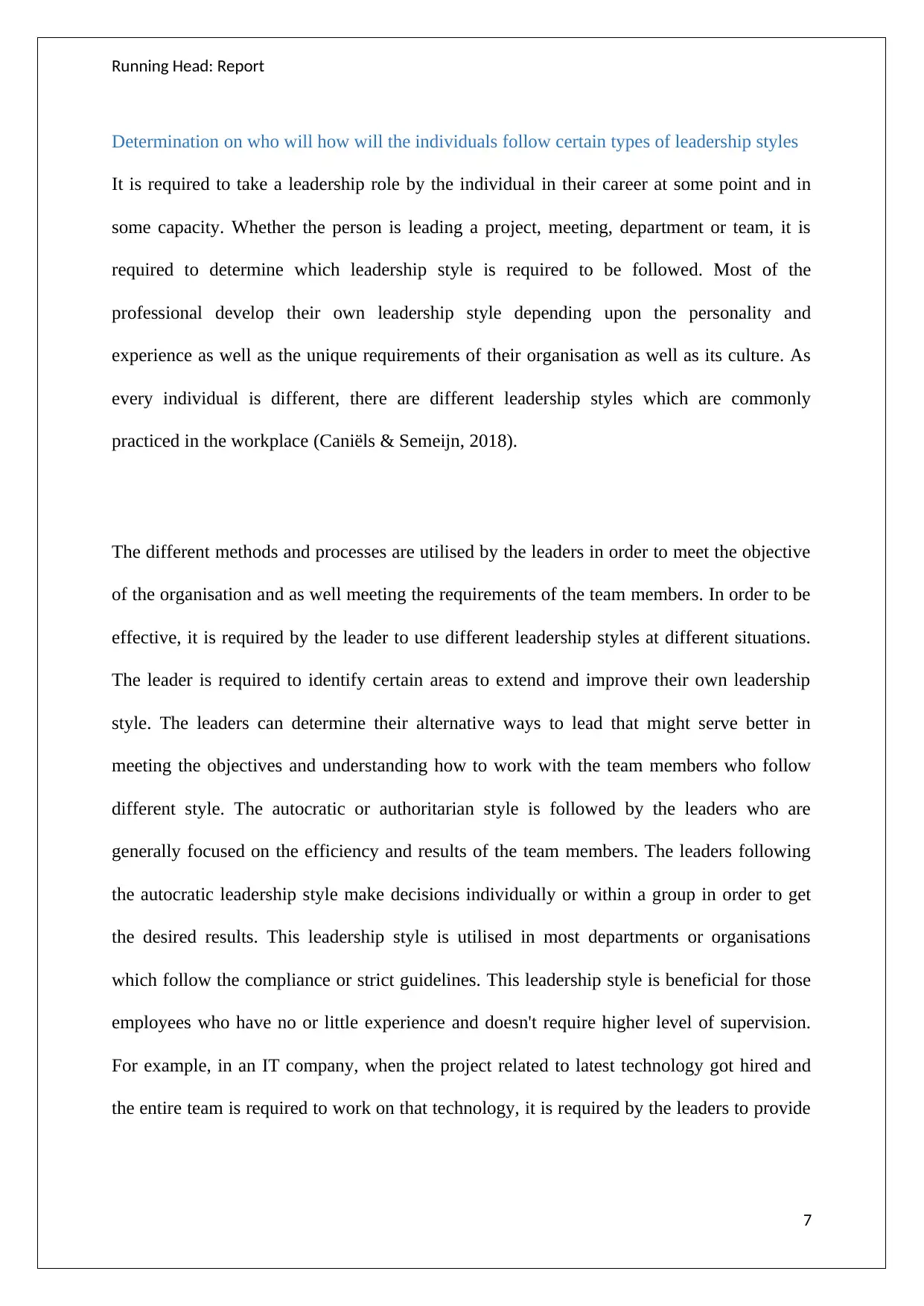
Running Head: Report
Determination on who will how will the individuals follow certain types of leadership styles
It is required to take a leadership role by the individual in their career at some point and in
some capacity. Whether the person is leading a project, meeting, department or team, it is
required to determine which leadership style is required to be followed. Most of the
professional develop their own leadership style depending upon the personality and
experience as well as the unique requirements of their organisation as well as its culture. As
every individual is different, there are different leadership styles which are commonly
practiced in the workplace (Caniëls & Semeijn, 2018).
The different methods and processes are utilised by the leaders in order to meet the objective
of the organisation and as well meeting the requirements of the team members. In order to be
effective, it is required by the leader to use different leadership styles at different situations.
The leader is required to identify certain areas to extend and improve their own leadership
style. The leaders can determine their alternative ways to lead that might serve better in
meeting the objectives and understanding how to work with the team members who follow
different style. The autocratic or authoritarian style is followed by the leaders who are
generally focused on the efficiency and results of the team members. The leaders following
the autocratic leadership style make decisions individually or within a group in order to get
the desired results. This leadership style is utilised in most departments or organisations
which follow the compliance or strict guidelines. This leadership style is beneficial for those
employees who have no or little experience and doesn't require higher level of supervision.
For example, in an IT company, when the project related to latest technology got hired and
the entire team is required to work on that technology, it is required by the leaders to provide
7
Determination on who will how will the individuals follow certain types of leadership styles
It is required to take a leadership role by the individual in their career at some point and in
some capacity. Whether the person is leading a project, meeting, department or team, it is
required to determine which leadership style is required to be followed. Most of the
professional develop their own leadership style depending upon the personality and
experience as well as the unique requirements of their organisation as well as its culture. As
every individual is different, there are different leadership styles which are commonly
practiced in the workplace (Caniëls & Semeijn, 2018).
The different methods and processes are utilised by the leaders in order to meet the objective
of the organisation and as well meeting the requirements of the team members. In order to be
effective, it is required by the leader to use different leadership styles at different situations.
The leader is required to identify certain areas to extend and improve their own leadership
style. The leaders can determine their alternative ways to lead that might serve better in
meeting the objectives and understanding how to work with the team members who follow
different style. The autocratic or authoritarian style is followed by the leaders who are
generally focused on the efficiency and results of the team members. The leaders following
the autocratic leadership style make decisions individually or within a group in order to get
the desired results. This leadership style is utilised in most departments or organisations
which follow the compliance or strict guidelines. This leadership style is beneficial for those
employees who have no or little experience and doesn't require higher level of supervision.
For example, in an IT company, when the project related to latest technology got hired and
the entire team is required to work on that technology, it is required by the leaders to provide
7
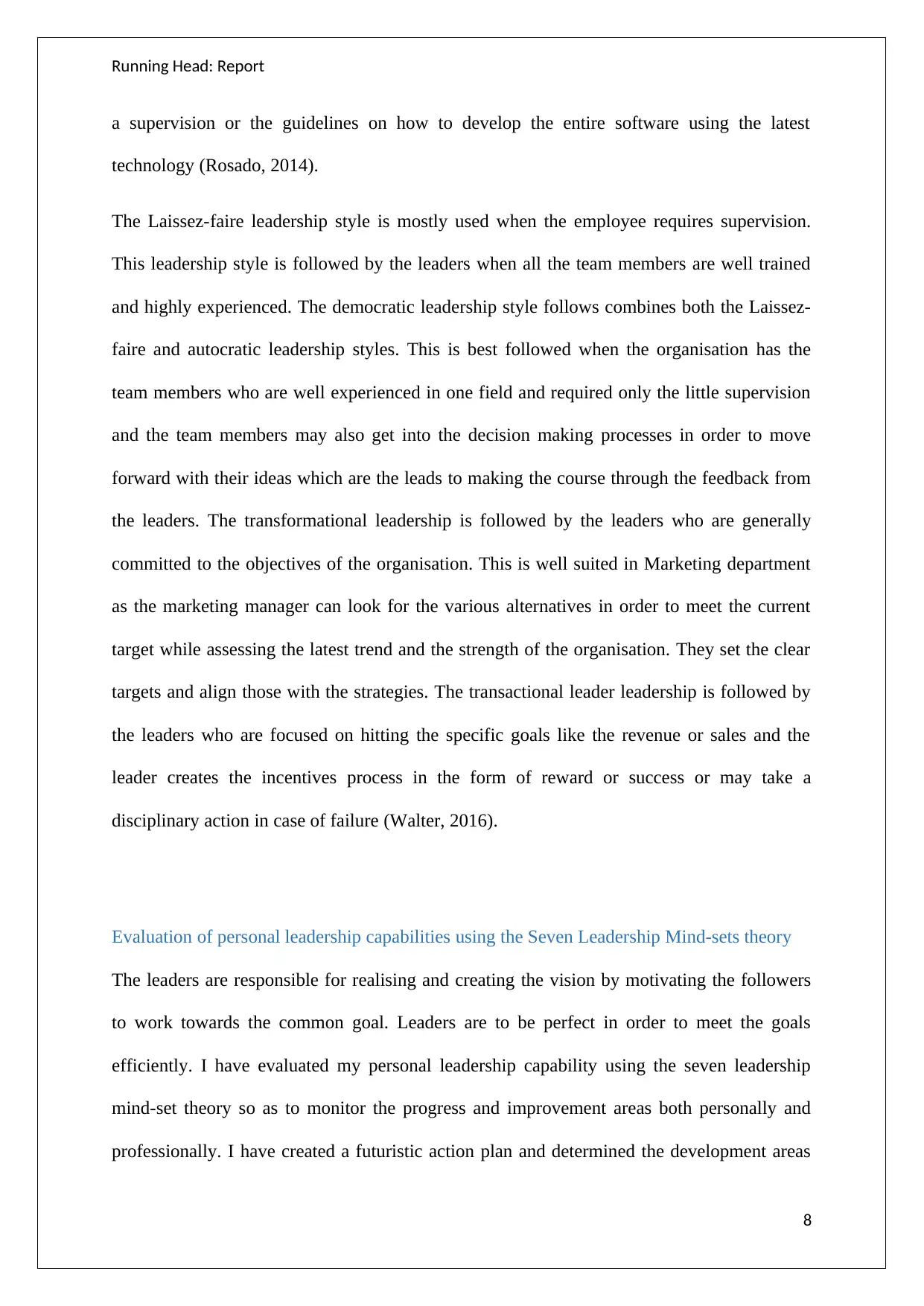
Running Head: Report
a supervision or the guidelines on how to develop the entire software using the latest
technology (Rosado, 2014).
The Laissez-faire leadership style is mostly used when the employee requires supervision.
This leadership style is followed by the leaders when all the team members are well trained
and highly experienced. The democratic leadership style follows combines both the Laissez-
faire and autocratic leadership styles. This is best followed when the organisation has the
team members who are well experienced in one field and required only the little supervision
and the team members may also get into the decision making processes in order to move
forward with their ideas which are the leads to making the course through the feedback from
the leaders. The transformational leadership is followed by the leaders who are generally
committed to the objectives of the organisation. This is well suited in Marketing department
as the marketing manager can look for the various alternatives in order to meet the current
target while assessing the latest trend and the strength of the organisation. They set the clear
targets and align those with the strategies. The transactional leader leadership is followed by
the leaders who are focused on hitting the specific goals like the revenue or sales and the
leader creates the incentives process in the form of reward or success or may take a
disciplinary action in case of failure (Walter, 2016).
Evaluation of personal leadership capabilities using the Seven Leadership Mind-sets theory
The leaders are responsible for realising and creating the vision by motivating the followers
to work towards the common goal. Leaders are to be perfect in order to meet the goals
efficiently. I have evaluated my personal leadership capability using the seven leadership
mind-set theory so as to monitor the progress and improvement areas both personally and
professionally. I have created a futuristic action plan and determined the development areas
8
a supervision or the guidelines on how to develop the entire software using the latest
technology (Rosado, 2014).
The Laissez-faire leadership style is mostly used when the employee requires supervision.
This leadership style is followed by the leaders when all the team members are well trained
and highly experienced. The democratic leadership style follows combines both the Laissez-
faire and autocratic leadership styles. This is best followed when the organisation has the
team members who are well experienced in one field and required only the little supervision
and the team members may also get into the decision making processes in order to move
forward with their ideas which are the leads to making the course through the feedback from
the leaders. The transformational leadership is followed by the leaders who are generally
committed to the objectives of the organisation. This is well suited in Marketing department
as the marketing manager can look for the various alternatives in order to meet the current
target while assessing the latest trend and the strength of the organisation. They set the clear
targets and align those with the strategies. The transactional leader leadership is followed by
the leaders who are focused on hitting the specific goals like the revenue or sales and the
leader creates the incentives process in the form of reward or success or may take a
disciplinary action in case of failure (Walter, 2016).
Evaluation of personal leadership capabilities using the Seven Leadership Mind-sets theory
The leaders are responsible for realising and creating the vision by motivating the followers
to work towards the common goal. Leaders are to be perfect in order to meet the goals
efficiently. I have evaluated my personal leadership capability using the seven leadership
mind-set theory so as to monitor the progress and improvement areas both personally and
professionally. I have created a futuristic action plan and determined the development areas
8
⊘ This is a preview!⊘
Do you want full access?
Subscribe today to unlock all pages.

Trusted by 1+ million students worldwide
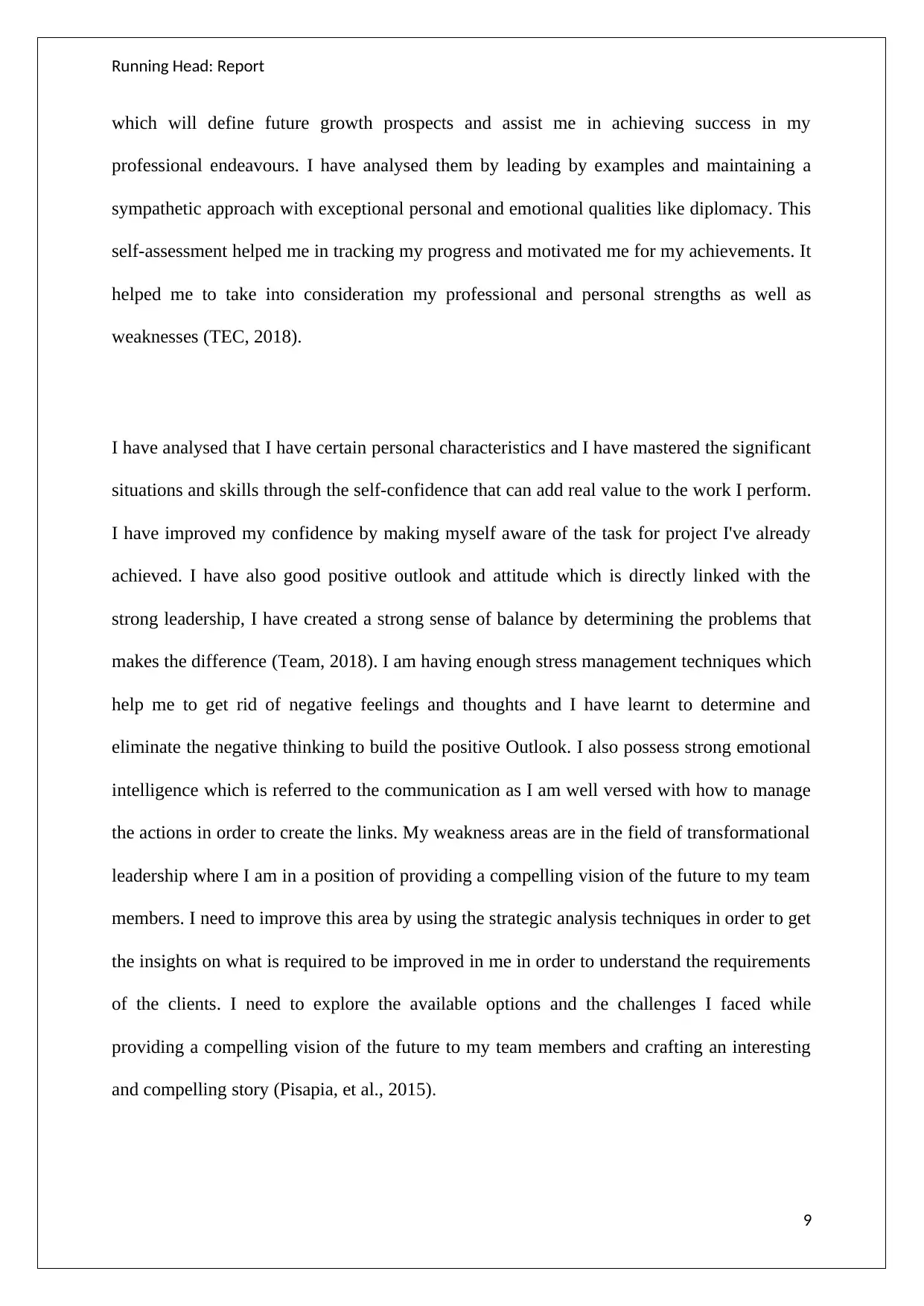
Running Head: Report
which will define future growth prospects and assist me in achieving success in my
professional endeavours. I have analysed them by leading by examples and maintaining a
sympathetic approach with exceptional personal and emotional qualities like diplomacy. This
self-assessment helped me in tracking my progress and motivated me for my achievements. It
helped me to take into consideration my professional and personal strengths as well as
weaknesses (TEC, 2018).
I have analysed that I have certain personal characteristics and I have mastered the significant
situations and skills through the self-confidence that can add real value to the work I perform.
I have improved my confidence by making myself aware of the task for project I've already
achieved. I have also good positive outlook and attitude which is directly linked with the
strong leadership, I have created a strong sense of balance by determining the problems that
makes the difference (Team, 2018). I am having enough stress management techniques which
help me to get rid of negative feelings and thoughts and I have learnt to determine and
eliminate the negative thinking to build the positive Outlook. I also possess strong emotional
intelligence which is referred to the communication as I am well versed with how to manage
the actions in order to create the links. My weakness areas are in the field of transformational
leadership where I am in a position of providing a compelling vision of the future to my team
members. I need to improve this area by using the strategic analysis techniques in order to get
the insights on what is required to be improved in me in order to understand the requirements
of the clients. I need to explore the available options and the challenges I faced while
providing a compelling vision of the future to my team members and crafting an interesting
and compelling story (Pisapia, et al., 2015).
9
which will define future growth prospects and assist me in achieving success in my
professional endeavours. I have analysed them by leading by examples and maintaining a
sympathetic approach with exceptional personal and emotional qualities like diplomacy. This
self-assessment helped me in tracking my progress and motivated me for my achievements. It
helped me to take into consideration my professional and personal strengths as well as
weaknesses (TEC, 2018).
I have analysed that I have certain personal characteristics and I have mastered the significant
situations and skills through the self-confidence that can add real value to the work I perform.
I have improved my confidence by making myself aware of the task for project I've already
achieved. I have also good positive outlook and attitude which is directly linked with the
strong leadership, I have created a strong sense of balance by determining the problems that
makes the difference (Team, 2018). I am having enough stress management techniques which
help me to get rid of negative feelings and thoughts and I have learnt to determine and
eliminate the negative thinking to build the positive Outlook. I also possess strong emotional
intelligence which is referred to the communication as I am well versed with how to manage
the actions in order to create the links. My weakness areas are in the field of transformational
leadership where I am in a position of providing a compelling vision of the future to my team
members. I need to improve this area by using the strategic analysis techniques in order to get
the insights on what is required to be improved in me in order to understand the requirements
of the clients. I need to explore the available options and the challenges I faced while
providing a compelling vision of the future to my team members and crafting an interesting
and compelling story (Pisapia, et al., 2015).
9
Paraphrase This Document
Need a fresh take? Get an instant paraphrase of this document with our AI Paraphraser
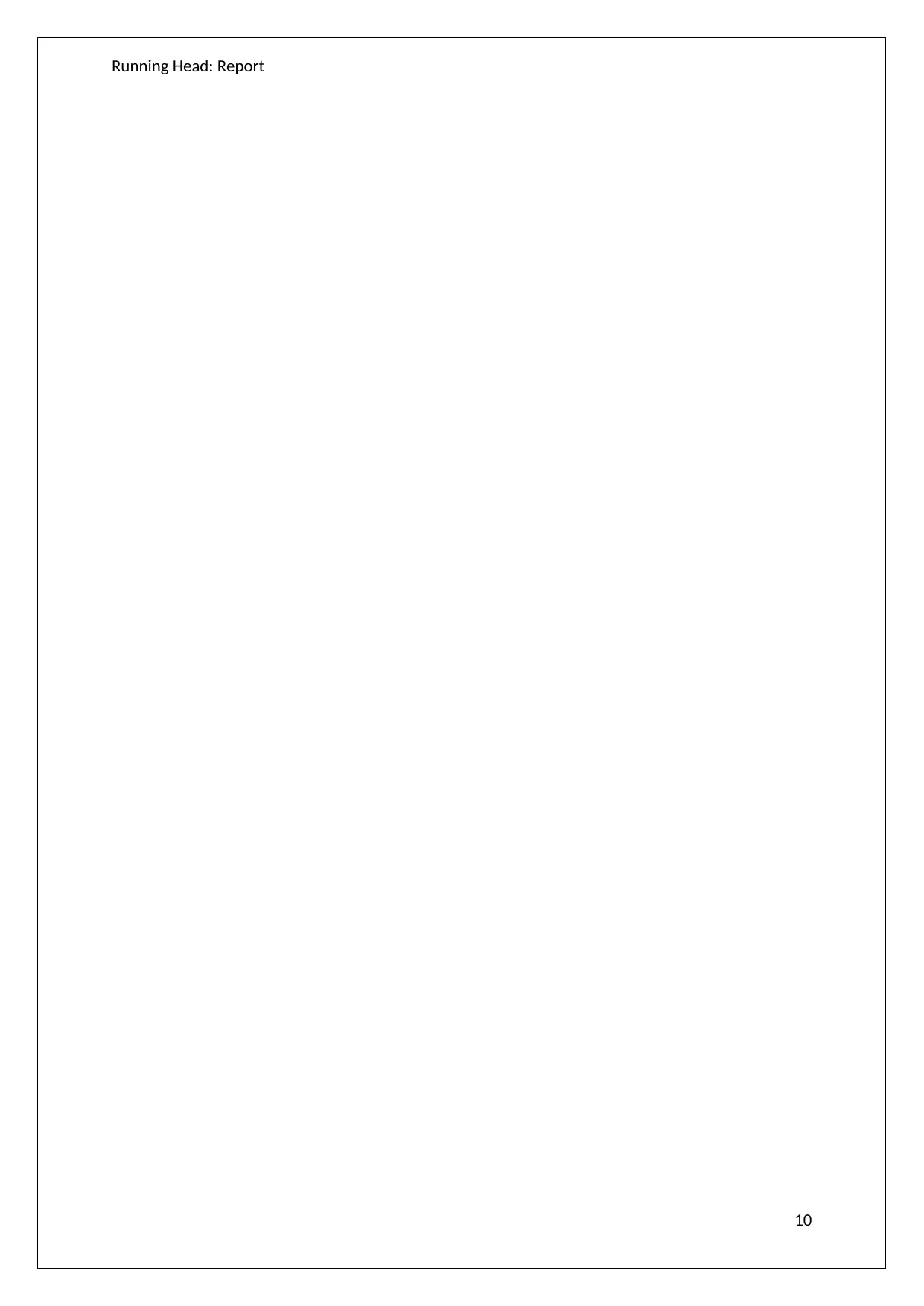
Running Head: Report
10
10
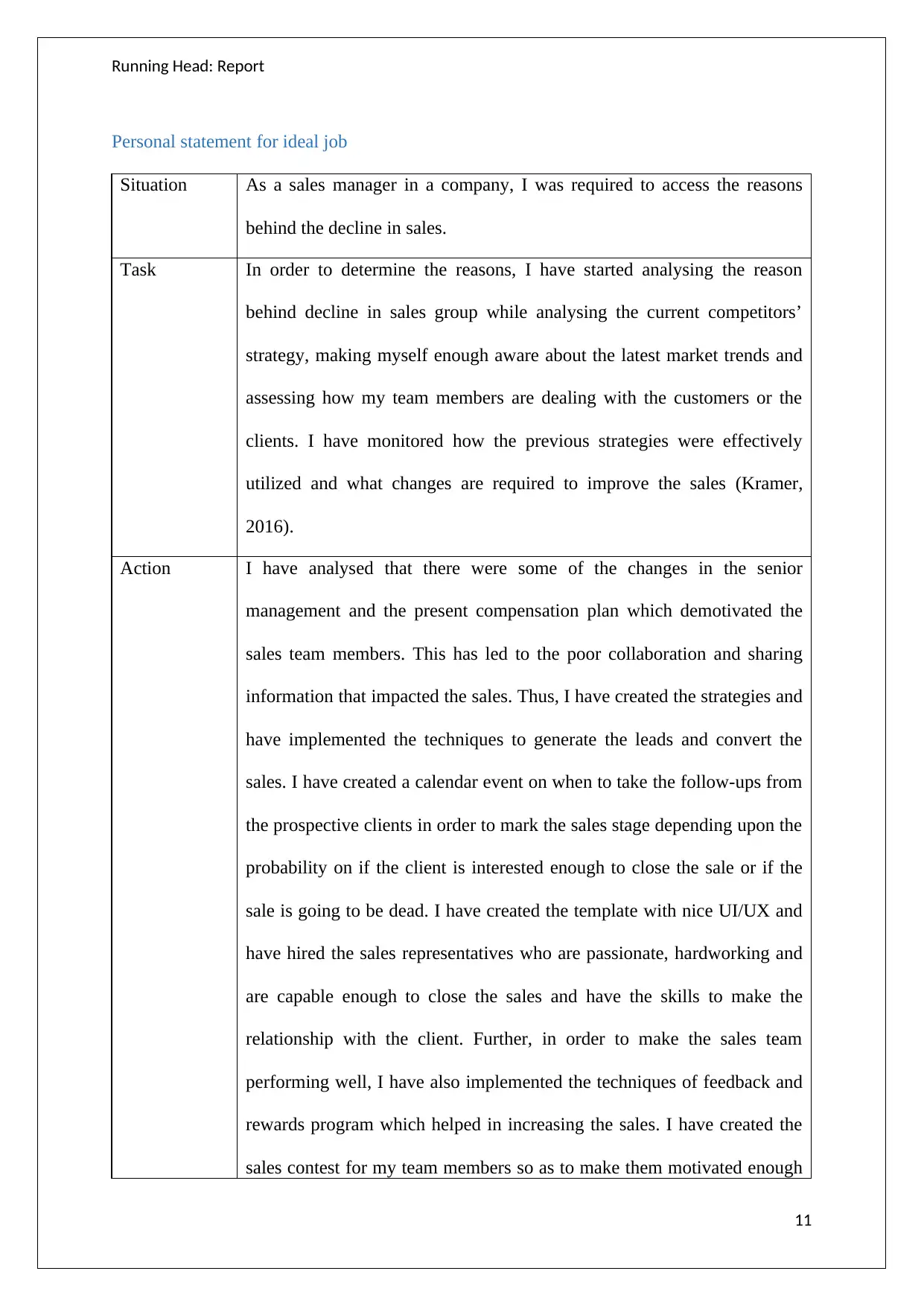
Running Head: Report
Personal statement for ideal job
Situation As a sales manager in a company, I was required to access the reasons
behind the decline in sales.
Task In order to determine the reasons, I have started analysing the reason
behind decline in sales group while analysing the current competitors’
strategy, making myself enough aware about the latest market trends and
assessing how my team members are dealing with the customers or the
clients. I have monitored how the previous strategies were effectively
utilized and what changes are required to improve the sales (Kramer,
2016).
Action I have analysed that there were some of the changes in the senior
management and the present compensation plan which demotivated the
sales team members. This has led to the poor collaboration and sharing
information that impacted the sales. Thus, I have created the strategies and
have implemented the techniques to generate the leads and convert the
sales. I have created a calendar event on when to take the follow-ups from
the prospective clients in order to mark the sales stage depending upon the
probability on if the client is interested enough to close the sale or if the
sale is going to be dead. I have created the template with nice UI/UX and
have hired the sales representatives who are passionate, hardworking and
are capable enough to close the sales and have the skills to make the
relationship with the client. Further, in order to make the sales team
performing well, I have also implemented the techniques of feedback and
rewards program which helped in increasing the sales. I have created the
sales contest for my team members so as to make them motivated enough
11
Personal statement for ideal job
Situation As a sales manager in a company, I was required to access the reasons
behind the decline in sales.
Task In order to determine the reasons, I have started analysing the reason
behind decline in sales group while analysing the current competitors’
strategy, making myself enough aware about the latest market trends and
assessing how my team members are dealing with the customers or the
clients. I have monitored how the previous strategies were effectively
utilized and what changes are required to improve the sales (Kramer,
2016).
Action I have analysed that there were some of the changes in the senior
management and the present compensation plan which demotivated the
sales team members. This has led to the poor collaboration and sharing
information that impacted the sales. Thus, I have created the strategies and
have implemented the techniques to generate the leads and convert the
sales. I have created a calendar event on when to take the follow-ups from
the prospective clients in order to mark the sales stage depending upon the
probability on if the client is interested enough to close the sale or if the
sale is going to be dead. I have created the template with nice UI/UX and
have hired the sales representatives who are passionate, hardworking and
are capable enough to close the sales and have the skills to make the
relationship with the client. Further, in order to make the sales team
performing well, I have also implemented the techniques of feedback and
rewards program which helped in increasing the sales. I have created the
sales contest for my team members so as to make them motivated enough
11
⊘ This is a preview!⊘
Do you want full access?
Subscribe today to unlock all pages.

Trusted by 1+ million students worldwide
1 out of 16
Related Documents
Your All-in-One AI-Powered Toolkit for Academic Success.
+13062052269
info@desklib.com
Available 24*7 on WhatsApp / Email
![[object Object]](/_next/static/media/star-bottom.7253800d.svg)
Unlock your academic potential
Copyright © 2020–2025 A2Z Services. All Rights Reserved. Developed and managed by ZUCOL.




